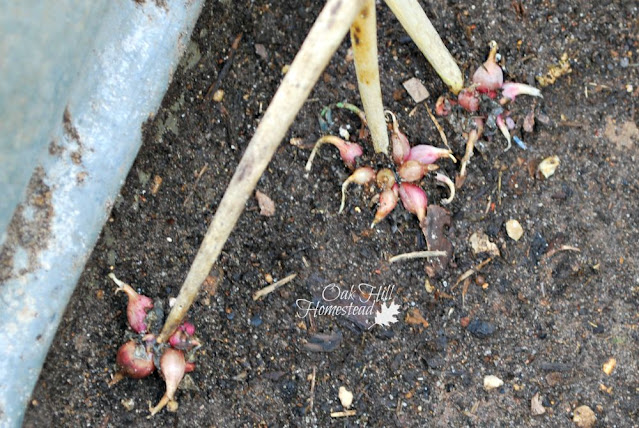A few years ago a friend gave me a clump of walking onions from her patch. I'd been fascinated by them for some years and was thrilled to add them to my garden.
Walking onions are perennials, which means they overwinter and grow back when the weather warms up. I've been adding perennial vegetables to my garden lately, so the walking onions were a great addition.
My onion patch started out with the small plants from my friend, and as that summer passed the onion bulbs grew in size. The stalks grew taller and eventually they bloomed, just like regular onion plants do.
But unlike regular onions, walking onions don't make seeds.
Instead, the walking onion's flowers turn into little onion bulblets on the end of the stalks. As the bulblets grow, they get heavy. The stalks bend over under the weight, and the bulblets touch the ground where they take root and grow more onion plants.
Nature is so cool!
Since I planted my starts in a large washtub, the bulblets were trying to land in the grassy yard and take root there. This is how they get their name: the plants "walk" across the garden as the seasons go by.
They are also known as multiplier onions because they multiply on their own so easily.
To encourage these onions to stay in the tub where I wanted them, I wiggled a little depression into the soil with my finger, bent the stalk a little more and set the bulblet in the hole, nestling it into the loose soil. They took root and grew more onions.
If you want to start onion plants in another spot or give some to a friend, cut the stalk with the bulblets and plant where desired. They're quite easy to establish in a new place.
Walking onions are very versatile.
The hollow onion stalks can be cut and eaten like green onions, or you can harvest the small onion bulblets.
The older, large onions can also be harvested, but be sure to leave some to continue growing and keep your patch going.
The little bulblets can also be separated and planted individually. Planting them farther apart - about six inches or so - will give you larger onion bulbs.
If you plan to harvest some as green onions, you can plant them closer together or just let them root and grow where the bulblets fall over instead of dividing and replanting them.
Like regular onions, walking onions like well-drained, organic soil. Keep your onion patch weeded so the weeds won't compete with your plants for water.
Divide your mature onion plants about every three years for maximum production.
Don't you just love perennial vegetables? Just plant them once, then feed, water and weed them like the rest of your garden, and reap the harvest for years to come.
For more gardening and homesteading posts subscribe to the Acorn, Oak Hill Homestead's weekly-ish newsletter, and join me on Facebook, Pinterest, and Instagram. I'd love to see you there!
~~~~~
My hope is to inspire you, and to encourage your homesteading plans and your dreams of a simple, self-reliant, God-dependent life. You can join me at:
Facebook | Pinterest | Instagram | Subscribe
















